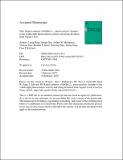Files in this item
Rapid synthesis of BiOBrxI1-x photocatalysts : insights to the visible-light photocatalytic activity and strong deviation from Vegard’s Law
Item metadata
| dc.contributor.author | Kong, Liang | |
| dc.contributor.author | Guo, Junqiu | |
| dc.contributor.author | Makepeace, Joshua W. | |
| dc.contributor.author | Xiao, Tiancun | |
| dc.contributor.author | Greer, Heather F. | |
| dc.contributor.author | Zhou, Wuzong | |
| dc.contributor.author | Jiang, Zheng | |
| dc.contributor.author | Edwards, Peter P. | |
| dc.date.accessioned | 2020-02-11T00:34:47Z | |
| dc.date.available | 2020-02-11T00:34:47Z | |
| dc.date.issued | 2019-02-11 | |
| dc.identifier | 257744042 | |
| dc.identifier | f959c66b-9983-4a54-8e7d-35d087ced501 | |
| dc.identifier | 85061817383 | |
| dc.identifier | 000475744800058 | |
| dc.identifier.citation | Kong , L , Guo , J , Makepeace , J W , Xiao , T , Greer , H F , Zhou , W , Jiang , Z & Edwards , P P 2019 , ' Rapid synthesis of BiOBr x I 1-x photocatalysts : insights to the visible-light photocatalytic activity and strong deviation from Vegard’s Law ' , Catalysis Today , vol. In press . https://doi.org/10.1016/j.cattod.2019.02.013 | en |
| dc.identifier.issn | 0920-5861 | |
| dc.identifier.other | RIS: urn:00E546A5EA7C063EDC1AD43E0D9CD804 | |
| dc.identifier.other | ORCID: /0000-0001-9752-7076/work/58055102 | |
| dc.identifier.uri | https://hdl.handle.net/10023/19442 | |
| dc.description | This work was supported by the Royal Society for international collaboration grants (IE160277 and IE/CNSFC170670) and Sir John Houghton Fellowship in Jesus College at University of Oxford. ZJ appreciated the institutional GCRF fund from EPSRC and JG appreciates the EUSTICE scholarship from University of Southampton. | en |
| dc.description.abstract | A series of visible-light-responsive BiOBrxI1-x solid solutions were prepared by a rapid and efficient ultrasonication synthesis and applied in photodegradation of Rhodamine B in aqueous solution. The detailed characterisations showed that the lattice parameters and their band structures of the BiOBrxI1-x solid solutions significantly deviated from the well-established Vegard’s law for solid solution materials. The Mulliken electronegativity and valence band XPS analyses revealed that the substitution of Br by less electronegative iodine can simultaneously modulate the edges of conductance and valence band of the BiOBr, leading to nonlinear dependence of bandgap (Eg) on the halogen anion concentrations. Although the solid solution displayed superior RhB photodegration activity to BiOI, only Br-rich BiOBrxI1-x solid solutions (x>0.5) were more active than BiOBr and BiOI, with the optimal one is BiOBr0.75I0.25. The Br-dependence of bandstructure and photocatalytic activity for the BiOBrxI1-x solid solutions as well as their rate-limiting radical species were also clarified based on experimental and theoretical analyses. | |
| dc.format.extent | 950893 | |
| dc.language.iso | eng | |
| dc.relation.ispartof | Catalysis Today | en |
| dc.subject | BiOBrxI1-x | en |
| dc.subject | Solid solution | en |
| dc.subject | Band edges | en |
| dc.subject | Visible light photocatalysis | en |
| dc.subject | QD Chemistry | en |
| dc.subject | NDAS | en |
| dc.subject.lcc | QD | en |
| dc.title | Rapid synthesis of BiOBrxI1-x photocatalysts : insights to the visible-light photocatalytic activity and strong deviation from Vegard’s Law | en |
| dc.type | Journal article | en |
| dc.contributor.institution | University of St Andrews. School of Chemistry | en |
| dc.contributor.institution | University of St Andrews. EaSTCHEM | en |
| dc.identifier.doi | 10.1016/j.cattod.2019.02.013 | |
| dc.description.status | Peer reviewed | en |
| dc.date.embargoedUntil | 2020-02-11 |
This item appears in the following Collection(s)
Items in the St Andrews Research Repository are protected by copyright, with all rights reserved, unless otherwise indicated.

